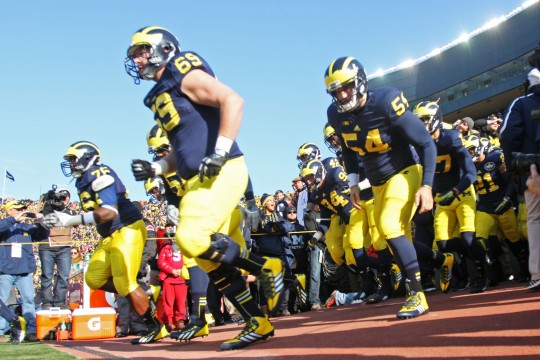
The Michigan Wolverines football team takes the field for a game against OSU on Nov. 30 at Michigan Stadium. OSU won, 42-41.
Credit: Lantern file photo
Anyone who follows college football even a little knows that the Southeastern Conference dominates the landscape.
But it wasn’t always that way.
As I sat in my living room late Wednesday night after coming home from work, I turned on the TV, and after a few minutes of channel surfing (us men are so good at that, right, ladies?) I came across the 2004 Michigan-Michigan State football matchup and began to watch.
In the game itself, No. 12 Michigan defeated unranked Michigan State in what is arguably one of the best games Michigan Stadium has ever seen. The Wolverines won in triple overtime, 45-37, behind 224 yards on the ground from then-freshman running back Mike Hart and 189 receiving yards from then-senior wide receiver Braylon Edwards.
While those names might make some Buckeye fans cringe, the fact remains that they were good, if not great, ballplayers and they made Michigan a contender in the Big Ten. Then it hit me — the key to a successful Big Ten is the success of Michigan.
Now, is it strictly just on the shoulders of the Wolverines to carry the Big Ten back to the promised land? Of course not.
The successes of other traditional Big Ten powers like Ohio State, Penn State and more recently Michigan State are also key, as the Buckeyes and Spartans have carried the conference in recent years.
But let’s go back to that 2004 season.
Michigan went to the Rose Bowl and lost to Texas, despite being upset in its season finale by the Buckeyes in Columbus as the No. 7 team in the country.
The SEC had just one team in the BCS that season, as Auburn won a low-scoring affair against Virginia Tech in the Sugar Bowl, 16-13.
Not quite so dominating, right?
So where did the tables turn on the Big Ten? How was the SEC able to separate itself?
Well, let’s start with the next three seasons.
A certain coach you might have heard of named Urban Meyer was hired at Florida late in 2004 to take over for a program that had started to reel under Ron Zook. Where did the struggling Zook find work? Illinois, the traditional Big Ten doormat.
Just a season later, Meyer’s Gators were putting a beating on the Buckeyes in the 2007 BCS National Championship game, which began a string of seven straight years of SEC dominance in title games.
Building on that, Wisconsin coach Barry Alvarez, who was largely responsible for the turnaround of the Wisconsin program in the early ‘90s, retired following the 2005 season, leaving the door open for Bret Bielema.
And we all know how that turned out. The Badgers would finish 2-4 in bowl games under Bielema.
In 2007, Michigan dropped a game to Appalachian State which, let’s be honest, was the beginning of the end for Wolverine legend Lloyd Carr’s coaching career.
So with Carr and Alvarez gone, and Jim Tressel’s Buckeyes dropping back-to-back blowouts in national championship games, the Big Ten took a dive into the deep end it has not yet come up from.
The addition of Meyer to the Buckeye staff following the Tattoo-Gate fallout saved the OSU program, but unfortunately for Michigan, it has not had the same success in hiring a coach since Carr’s departure.
The Rich Rodriguez experiment was a colossal failure and for a brief moment, it appeared the hiring of proclaimed “Michigan Man” Brady Hoke would resurrect the once proud program.
For the 2011 season, it appeared Hoke had done just that as the Wolverines exploded to a 11-2 season which culminated in back-to-back wins over the Buckeyes and the Virginia Tech Hokies in the Sugar Bowl.
But the wheels have fallen off quickly for the Wolverines and the Big Ten, as Michigan sits at 3-4 on the season, and is, quite frankly, struggling to make a bowl game. Combine that with the Shane Morris incident in which Hoke played the clearly injured quarterback following a ruthless hit from a Minnesota defender, and we have seen a once-dominant program reduced to a laughing stock.
The recent downward spiral of the Michigan program led them to lower their student ticket prices Thursday down to $175 from $280 for seven home games for the 2015 season in an effort to increase attendance.
While it might be fun for Buckeye fans to see their rival fall from the graces of college football’s best, it is quite frankly awful for the Big Ten conference.
And as the Wolverines get ready to take on the Spartans this weekend, now 10 years later, one cannot help but wonder if the Michigan program, and the Big Ten conference, will ever be able to recover from the ranks of mediocrity.

